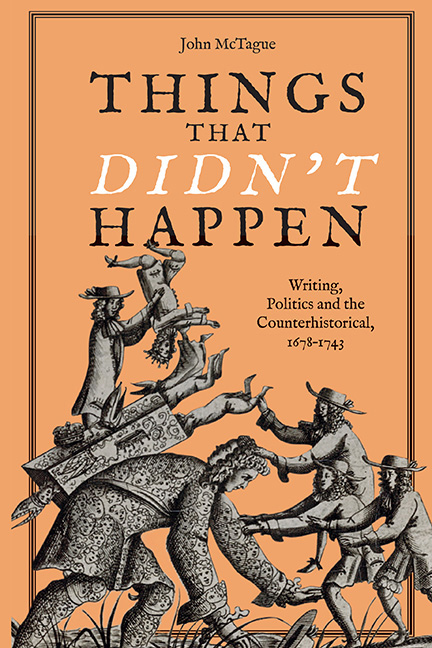Book contents
- Frontmatter
- Dedication
- Contents
- List of Illustrations
- Acknowledgements
- List of Abbreviations
- Introduction
- I Fabrications
- 1 Incorrigibility: The Warming Pan Scandal of 1688–89
- 2 ‘Working in th'immediate power to be’: The Popish and Protestant Plots
- II Failures
- III Speculations
- IV The Dunciads
- Conclusion: Events that Didn't Happen
- Bibliography
- Index
2 - ‘Working in th'immediate power to be’: The Popish and Protestant Plots
from I - Fabrications
Published online by Cambridge University Press: 09 October 2019
- Frontmatter
- Dedication
- Contents
- List of Illustrations
- Acknowledgements
- List of Abbreviations
- Introduction
- I Fabrications
- 1 Incorrigibility: The Warming Pan Scandal of 1688–89
- 2 ‘Working in th'immediate power to be’: The Popish and Protestant Plots
- II Failures
- III Speculations
- IV The Dunciads
- Conclusion: Events that Didn't Happen
- Bibliography
- Index
Summary
THIS chapter explores what The Life of King James the Second meant when it cited the king's subjects’ ability to ‘reconcile’ the ‘Paradoxes’ inherent in the warming-pan fiction, an ability he connected to the fact that they were ‘a people accostomed to believe […] the contradictions of Oates's plot’. This conspiracy is now known as the Popish Plot, named for the main progenitor of this series of interrelated narratives: Titus Oates. A former Catholic, Oates insisted that his conversion to the Roman faith was itself an act of subterfuge, enabling him to gather information about a Jesuit plot to overthrow the government, and Protestantism in England. The murder on 12 October 1678 of Sir Edmund Berry Godfrey, the justice of the peace who had first taken Oates's depositions, helped his credibility: the assumption was that Godfrey had been murdered by Catholics seeking to suppress Oates's revelations. Oates's narrative was supplemented (and occasionally contradicted) by the testimonies of William Bedloe, Stephen Dugdale, and Miles Prance. Broadly speaking, the ‘Popish Plot’ consisted of: plans to assassinate Charles II and James; rebellions across the British Isles; repeated attempts to fire London (including the Great Fire of 1666, still at this time laid at the door of Catholics); and detailed plans for the re-establishment of Catholicism in England, including a list of those who could expect bishoprics, come the counterreformation. This was an alternative but dangerously proximate past and future, according to Oates and his fellow informers. It was also a partisan counterhistory that had demonstrable and tragic effects: by July 1681 thirty-five men had been executed for their alleged involvement in the plot. For much of this political crisis, as Roger L'Estrange found, expressing scepticism about the veracity of Oates's narrative was perceived as bordering on treason. However, by 1681, as Charles prorogued what was to be his last parliament and began proceedings to revoke the charter of the city of London, Oates's plot seemed much less unassailable. This was in part because it had begun to be challenged by rival conspiracy narratives, including the ‘Protestant Plot’ (an alleged plan to kidnap the king at the 1681 Oxford parliament in order to bring him to terms).
- Type
- Chapter
- Information
- Things that Didn't HappenWriting, Politics and the Counterhistorical, 1678–1743, pp. 55 - 84Publisher: Boydell & BrewerPrint publication year: 2019



